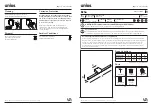
1xEV-DO Measurements
R&S
®
CMW-KG8xx/-KM8xx/-KS8xx
256
User Manual 1173.9511.02 ─ 11
Fig. 3-7: Modulation limit settings
3.2.7.2
Code Domain Limits
Whether or not a code channel is considered inactive and a limit check is performed
depends on the I/Q leakage check. The leakage check can also be activated/deactiva-
ted. The checkboxes activate/deactivate the limit checks:
●
Leakage check not active (conform to 3GPP2): A code channel is considered inac-
tive if both I-branch and Q-branch of the channel are inactive. If at least one branch
is active, no limit check is performed.
●
Leakage check active: A code channel is considered inactive if at least one branch
(I or Q) is inactive. In that case a limit check is performed for the inactive branch /
branches.
Code domain power is defined relative to the total power of the signal, so none of the
individual CDP contributions can be larger than 0 dB. Minimum requirements for the
code domain power are defined in 3GPP2 C.S0033-B, section 4.3.8, "Code Domain
Power". The I and Q components of the code domain power of an inactive channel
shall be at least 23 dB below the total output power. The CDP limit can be set in the
configuration dialog along with a limit for the code domain error.
Code domain error is computed by projecting power of the error vector onto the code
domain at a specific spreading factor. The CDE for every code in the domain is defined
as the ratio of the mean power of the projection onto that code, to the mean power of
the composite reference waveform. This ratio is expressed in dB.
Channel power limits are similar to code domain power limits, but apply to named
1xEV-DO channels only.
For the Walsh function used by 1xEV-DO channels see
General Description
深圳德标仪器
135-1095-0799
















































